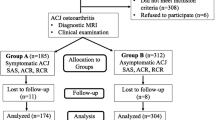Abstract
Hypothesis
Arthroscopic acromioclavicular joint (ACJ) resection for asymptomatic ACJ arthritis combined with rotator cuff repair leads to more satisfactory pain relief and decrease reoperation rate when inferiorly directed osteophytes present at the undersurface of ACJ.
Materials and methods
Between January 2006 and May 2008, a total of 83 patients (83 shoulders), 40 males and 43 females, who were planned to have arthroscopic repair of a tear measuring 1–3 cm in the anterior-posterior dimension with advanced ACJ arthritis with inferiorly directed osteophytes at the undersurface of the ACJ on MRI were entered into this study. Patients were randomized into two groups. Group 1 included 31 patients, who underwent arthroscopic distal clavicle resection combined with rotator cuff repair. Group 2 included 52 patients, who underwent isolated rotator cuff repair. Patients were evaluated preoperatively and postoperatively using the University of California Los Angeles (UCLA) score and the American Shoulder and Elbow Surgeons (ASES) score. Pain, tenderness on ACJ, and cross body adduction test were compared between groups.
Results
The mean follow-up was 31.7 months (range 34–38). The UCLA scores and ASES scores were lower in group 1 at week 6 (p < .05), and week 12 (p < .05), but higher at the last follow-up at 2 years (p < .05) postoperatively. VAS score was higher in group 1 at week 6 (p < .05), and at week 12 (p < .05), but lower in group 2 at the last follow-up (p < .05). Only in group 2, two (3.8%) cases developed ACJ pain during follow-up and one (1.9%) case underwent reoperation for additional ACJ resection.
Conclusions
This study shows that distal clavicle resection combined with rotator cuff repair for asymptomatic ACJ arthritis with inferiorly directed osteophytes lower functional scores due to temporary pain in early postoperative periods, but better functional outcomes with satisfactory pain relief and no reoperation rate were observed after 2 years.








Similar content being viewed by others
References
Neer C (1990) Cuff tears, biceps lesions, and impingement. Shoulder reconstruction. Philadelphia, WB Saunders, pp 63–70
Edelson J (1996) Patterns of degenerative change in the acromioclavicular joint. J Bone Joint Surg Br Vol 78(2):242
Henry M, Liu S, Loffredo A (1995) Arthroscopic management of the acromioclavicular joint disorder: a review. Clin Orthop Relat Res 316:276
Neer C, Poppen N (1987) Supraspinatus outlet. Orthop Trans 11:234
Cuomo F et al (1998) The influence of acromioclavicular joint morphology on rotator cuff tears* 1. J Shoulder Elbow Surg 7(6):555–559
NEER C (1983) Impingement lesions. Clin Orthop Relat Res 173:70
Petersson C, Gentz C (1983) Ruptures of the supraspinatus tendon the significance of distally pointing acromioclavicular osteophytes. Clin Orthop Relat Res 174:143
Kessel L, Watson M (1977) The painful arc syndrome. Clinical classification as a guide to management. J Bone Joint Surg Br 59(2):166
Kuster M, Hales P, Davis S (1998) The effects of arthroscopic acromioplasty on the acromioclavicular joint. J Shoulder Elbow Surg 7(2):140–143
Gartsman G (1993) Arthroscopic resection of the acromioclavicular joint. Am J Sports Med 21(1):71
Rabalais R, McCarty E (2007) Surgical treatment of symptomatic acromioclavicular joint problems: a systematic review. Clin Orthop Relat Res 455:30
Cadet E, Ahmad C, Levine W (2006) The management of acromioclavicular joint osteoarthrosis: debride, resect, or leave it alone. Instr Course Lect 55:75
Matthews L, Parks B, Pavlovich L (1999) Arthroscopic versus open distal clavicle resection: a biomechanical analysis on a cadaveric model. Arthrosc J Arthrosc Relat Surg 15(3):237–240
Flatow E et al (1995) Arthroscopic resection of the distal clavicle with a superior approach. J Should Elb Surg/Am Should Elb Surg 4(1 Pt 1):41–50
Sher J et al (1995) Abnormal findings on magnetic resonance images of asymptomatic shoulders. J Bone Joint Surg 77(1):10
Stein B et al (2001) Detection of acromioclavicular joint pathology in asymptomatic shoulders with magnetic resonance imaging. J Shoulder Elbow Surg 10(3):204–208
DePalma A (1957) Degenerative changes in the sternoclavicular and acromioclavicular joints in various decades. Thomas, Springfield, IL
Rathbun J, Macnab I (1970) The microvascular pattern of the rotator cuff. J Bone Joint Surg Br 52(3):540
Watson M (1978) The refractory painful arc syndrome. J Bone Joint Surg Br Vol 60(4):544
Weber S (1999) Coplaning the acromioclavicular joint at the time of acromioplasty: a long-term study. Arthroscopy 15:555
Fukuda K et al (1986) Biomechanical study of the ligamentous system of the acromioclavicular joint. J Bone Joint Surg 68(3):434
Klimkiewicz J et al (1999) The acromioclavicular capsule as a restraint to posterior translation of the clavicle: a biomechanical analysis. J Shoulder Elbow Surg 8(2):119–124
Conflict of interest
None.
Author information
Authors and Affiliations
Corresponding author
Rights and permissions
About this article
Cite this article
Kim, J., Chung, J. & Ok, H. Asymptomatic acromioclavicular joint arthritis in arthroscopic rotator cuff tendon repair: a prospective randomized comparison study. Arch Orthop Trauma Surg 131, 363–369 (2011). https://doi.org/10.1007/s00402-010-1216-y
Received:
Published:
Issue Date:
DOI: https://doi.org/10.1007/s00402-010-1216-y




